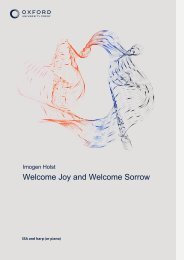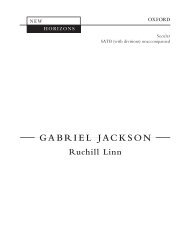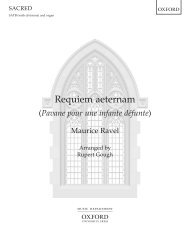New Oxford Organ Method
A single piece of repertoire is the primary focus for each chapter, with preparatory exercises providing the necessary technical work building towards the piece. Each lesson covers four main topics, which are systematically developed: practice methods, registration, fingering and pedalling, and historically-informed interpretation. The method is for keyboard players of any age who are establishing first steps at the organ with or without a teacher. It will also serve more experienced organists who want to improve their technique.
A single piece of repertoire is the primary focus for each chapter, with preparatory exercises providing the necessary technical work building towards the piece. Each lesson covers four main topics, which are systematically developed: practice methods, registration, fingering and pedalling, and historically-informed interpretation. The method is for keyboard players of any age who are establishing first steps at the organ with or without a teacher. It will also serve more experienced organists who want to improve their technique.
- No tags were found...
Create successful ePaper yourself
Turn your PDF publications into a flip-book with our unique Google optimized e-Paper software.
Chapter 19<br />
251<br />
Left foot on the Swell pedal<br />
So far, when operating the Swell pedal, you have only used your right foot, but at the start of Lento your right<br />
foot is unavailable, as otherwise your feet would cross uncomfortably. Without looking down, practise moving<br />
to and from the Swell pedal with your left foot. The next exercise begins with your right foot on the Swell<br />
pedal, then your left foot; meanwhile the other foot plays pedal notes. The directions suggest the approximate<br />
point at which to move your left foot to the Swell pedal. Place your hands on the key cheeks, and play:<br />
?<br />
Right foot on Swell pedal<br />
Left foot on Swell pedal<br />
m ¡ m ¡ m ¡ m ¡<br />
œ œ œ œ œ œ œ œ œ œ œ œ œ œ œ<br />
m ¡ m ¡ m ¡ m<br />
for online perusal only<br />
?<br />
Right foot on Swell pedal<br />
œ m œ ¡ œ m œ ¡ m ¡ m<br />
œ œ œ œ œ œ œ<br />
m ¡ m<br />
œ œ<br />
¡ m<br />
œ ˙<br />
¡ m<br />
¡Left<br />
foot on Swell pedal<br />
Structural analysis<br />
To make wise musical decisions from the outset, always begin by exploring the musical structure of a piece.<br />
Here the piece has a recurring bass figure, which you might not otherwise notice. The recurring bass figure<br />
is a short plaintive melody, which is restated seven more times, and absent only at the climax. The first<br />
statement moves from left hand to pedal:<br />
LH<br />
Ped.<br />
Sw.<br />
?# # 4<br />
˙ œ œ œ œ œ<br />
3<br />
?# # 4 ∑<br />
Sw. ¼ open<br />
∑<br />
w<br />
m<br />
∑<br />
(bb. 1–3)<br />
As the piece progresses, the figure undergoes three modifications: extra articulation, rhythmic change, and<br />
transposition.<br />
Extra articulation<br />
In the next exercise two statements of the plaintive figure overlap, but the final note is missing from the<br />
second statement. As you play, make the extra articulations subtle, without compromising the musical line:<br />
LH<br />
Sw.<br />
?# # 4<br />
˙ œ œ œ œ œ ˙ œ œ œ œ œ<br />
4 5 5 3 4 4 5 5 3<br />
Sw. closed<br />
(bass, bb. 11–14)<br />
continued...


















